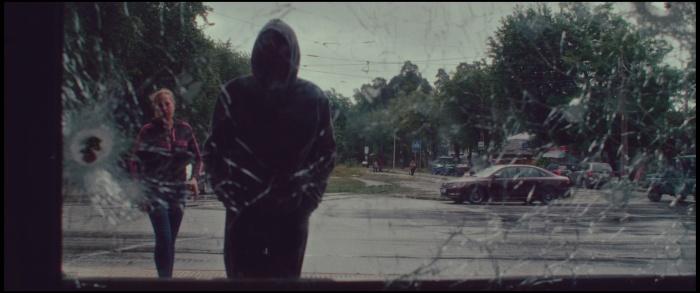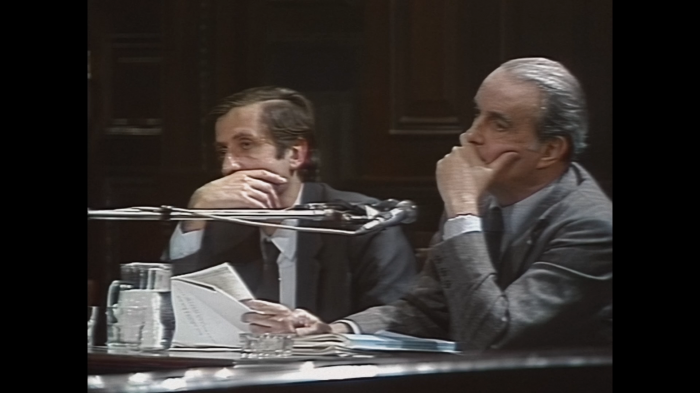
On 16 February 2022, the Reuters information agency started a video livestream from the Independence Square in Kyiv, seeking to be the first to have footage of the beginning of Russia’s full-scale invasion of Ukraine. Back then, instead of an online video stream about the war, the sensation-hungry news agency got an ironic advertisement “Garage at Soloma for Sale” with the number of the Russian Embassy in Kyiv, which residents of the capital attached to a drone which flew up to the camera. A week later, the world did indeed see the first footage of the full-scale invasion.
A red column of cars in three lanes, stretching for many kilometres ahead — a traffic jam at the exit from Kyiv.
A cloud of smoke rising on the horizon above private houses — an explosion after a missile strike in Odesa.
A bright yellow flame against the dark morning sky — Russian artillery shelling of Kharkiv.
A black hole in the asphalt and a burned car nearby — an enemy artillery strike on Uman, one person killed.
Then the volume of images of the war was growing at incredible speed. Sometimes new blood-curdling footage appeared online every hour, throwing one ever deeper into the bottomless pit of horror. Images of the bombed and destroyed Mykolaiv Regional Administration, videos of fearless Khersonians and Melitopolians who came out to stop Russian tanks with their bare hands. Footage from Mariupol. Photos from Bucha, Borodyanka, Izyum. The list goes on in both directions of the time axis: towards today or in the opposite direction, towards 2014 in Crimea or in Slovyansk, where a unit led by ex-FSB officer Strelkov-Girkin started seizing police departments in April.
The digital world mirrors our everyday life with countless images every day. The Russia-Ukraine war since 2014 is reflected in many terabytes of photos and videos floating freely online, which sometimes disappear at the bottom of archives and sometimes float up to the surface, picked up by social media algorithms. How do we construct narratives, history and chronology based on this array? How do we avoid losing ourselves, our memory in it and at the same time preserve our capacity to resist evil, defend ourselves from trauma, dream about the future?
This year’s DOCU/ART programme conceptualises an image in the digital world — particularly the image of war and war crimes — and the ways to rebuild one’s own history and future among thousands of images.
Moving from western Ukrainian cities via Kyiv to Kharkiv, the directors of In Ukraine — one of whom, Piotr Pawlus, combined travelling with volunteering since March last year — filmed the experience of war. The experience which, minute by minute, is made up from everyday life and resists exoticisation. Rusty broken Russian tanks on screen do not cause fear — instead, they stand still in front of kids who curiously ask their parents whose vehicles those are, and when they hear the answer, they punch the iron box a few times. Houses, black from attacks, are not standing as broken-tooth monuments to war crimes, but gradually and with care, window by window, get protected with plywood sheets. Images of the war, which have been exploited in the media many times, regain their mundane and three-dimensional aspect in the film by Wolski and Pawlus.
A still from the film In Ukraine
As they travel around Ukraine, the filmmakers also lay a route into the depths of the experience of war. From simple observation of the consequences of war in the streets to experiencing the war together with Ukrainians. During air raid sirens and explosions, at lunch in a Kharkiv Metro Shelter, waiting in ambush with Ukrainian soldiers in the woods, or in the darkness of a city during blackout abuzz with generator noises. At some point, the screen shows a scene from a cemetery, a newly planted garden of Ukrainian flags flying above fresh graves. A dense grove of unknown stories which were ended, stories behind each photo which make up the anonymous statistics, infographics and frontline maps every day — another widely broadcast media image of the war.
Notes from Eremocene is probably the most daring film experiment by a filmmaker whose previous works were also dedicated to the subject of post-human civilization — or more exactly, to artificial intelligence and the role or place of cinema in the digital world. Contemplating the future which can await us, Viera Čákanyová reaches the conclusion that it will be the time of Eremocene, the age of loneliness. The human being, who exterminates the planet’s biodiversity and kills people like a predator, will finally cease to exist, but there’s a catch. Humans will simply drown in digital copies of themselves, images deprived of originality. Endless pixels and algorithms in which almost any story, any meaning, not to mention human warmth can be lost. Human beings and their stories will fully become a function of computers or AIs, their endlessly copied product, and not the other way around. Video and photo archives will lose all meaning — memory of them will become a digital excerpt at most.
A still from the film Notes from Eremocene
However, in this cold future, Viera, in a dialogue with AI on behalf of a post-human, lays a difficult path to find her own true, original image — and this meeting becomes probably the warmest and most hopeful short-circuit which restores the old-fashioned question of morality to Eremocene.
The Trialis a monumental canvas made up of archive footage covering the trial of war criminals in Argentina in 1985. When the military junta fell, former high-ranking officials who terrorised citizens for seven years ended up as defendants in court. The director carefully examines almost 500 hours of recordings from the courtroom, picks the episodes and structures them into separate paragraphs which together create a three-dimensional panorama of what was happening in the country for years as a result of conscious purposeful orders by its political regime. We spend the entire film inside the courtroom, and the screen shows new and new witnesses and victims who recall horrifying events in detail. Filtration camps, kidnapping, intimidation, torture, basements, rape, murder. Crimes committed over 40 years ago often resemble stories from the Ukrainian territories which are temporarily occupied by Russia — except for the fact that in Argentina, these atrocities were committed against their own people.
A still from the film the Trialis
Without exploiting direct images of terror and evidence of violence, but relying on the power of words instead, the film still becomes a careful work with memory. No crime will be forgotten, no victim will become a component of the dictatorship’s cynical self-justification. A story after story is told in the courtroom, and it becomes clear that war criminals do not necessarily need even formal ideological reasons to kill thousands of people: this black hole opens when human life as such becomes a function for the predatory, ravenous dictatorship system and its Eichmann henchmen ready to enthusiastically carry out “cleansings.”
However, another equally important focus formed by the director from the archive footage in the film is the procedural nature of court hearings. Even when the defendants’ responsibility for the terror becomes ever more obvious, fair punishment and conversation about responsibility as such become possible only when, by adhering to procedures, society gradually returns to the rule of law and democratic processes. Sometimes this path seems ethically conflicted and painful. But only after completing it, Prosecutor Julio Strassera can finally tell the judges: “Never again!”
Main photo: a still from the film Notes from Eremocene.
Техт: Yulia Kovalenko, Programme Director of the 20th Docudays UA, coordinator of the non-competition programme DOCU/ART
_________
The 20th anniversary of Docudays UA is held with support from the Embassy of Sweden in Ukraine, the Embassy of Switzerland in Ukraine, the Ukrainian Cultural Foundation, US Embassy in Ukraine, the Embassy of Ireland in Ukraine, the Embassy of Denmark in Ukraine, the Embassy of Brazil in Ukraine, the Polish Institute in Kyiv and the Czech centre Kyiv. The opinions, conclusions or recommendations do not necessarily reflect the views of the governments or organisations of these countries. Responsibility for the content of the publication lies exclusively on the authors and editors of the publication.